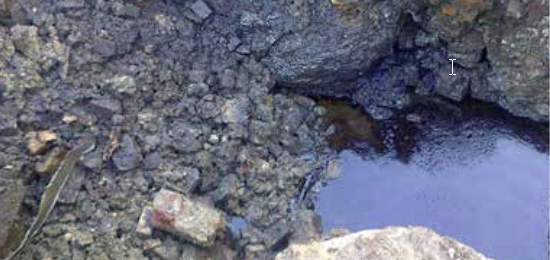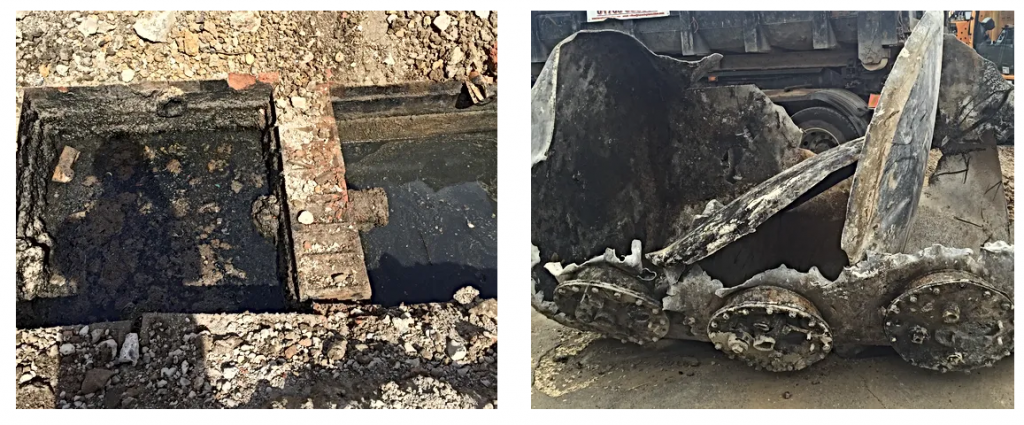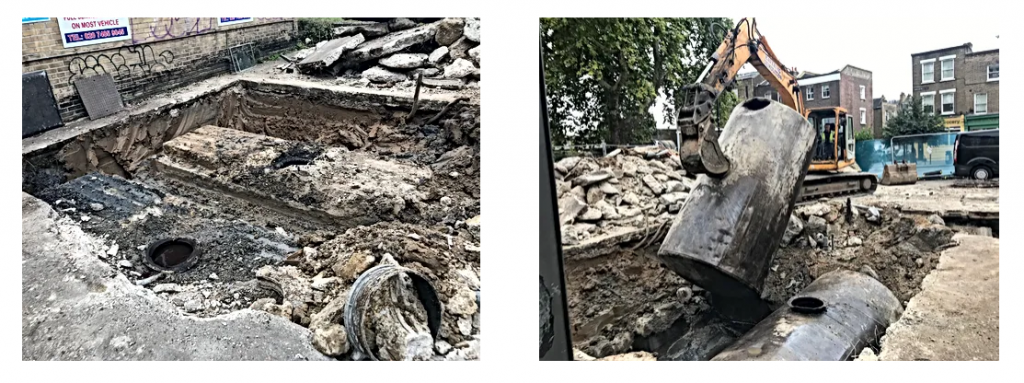Case Study
Tank Removal Remediation
Remediation of a Former Gasworks
Brook Street, Tring.
Lilygate Developments commissioned Jomas Associates Ltd to undertake a Geoenvironmental and Geotechnical ground investigation at the site Brook Street, Tring. The proposed development comprised the construction of new residential apartments with an associated partial basement car park.
Desk Study & Site Investigation
Historically, the site was part of a former Gas works. The results of Jomas’ investigation indicated the site to be overlain by an initial covering of Made Ground up to 2.0m bgl in depth, overlying a structureless clayey chalk. Evidence of contamination in the form of visual staining and a noticeable hydrocarbon odour was reported within the majority of trial pits and boreholes, at depths ranging from 1.0m to 6.0m bgl. The basement construction was undertaken under the supervision of Jomas Associates, to ensure remnants of the gas works, as well as impacted soils were removed and validate. The site was underlain by a Principal Aquifer, contained within the Chalk underlying the site.
Remediation
Jomas carried out risk assessments to determine if remediation was required for the protection of controlled waters. Jomas liaised with the Environment Agency to obtain sign off of the conclusions of the risk assessments, which concluded that a pollutant linkage did not exist related to controlled waters, and the Principal Aquifer.
Value Added
Risk Assessments were undertaken to demonstrate that a pollutant linage did not exist with regards to controlled waters, and the underlying CHALK Principal Aquifer. This was signed off by the Environment Agency.
Significant Remediation costs were avoided.


Remediation of a Former Petrol Filling Station
Mill Road, Maldon, Essex.
Jomas Associates were commissioned to manage the demolition and remediation of the former petrol filling station, presenting a site suitable for residential development, on completion. Jomas carried out a Site Reconnaissance, followed by the supplementary Ground Investigation, Remediation and Verification of Remedial works. Jomas were responsible for liaising with the Environmental Health Department at Maldon District Council, to enable the discharge of planning conditions relating to Land Contamination.
Desk Study and Site Investigation
The site comprised a vacant petrol filling station with 3 buildings and several buried fuel tanks, filled with concrete. A previous Environmental Investigation Report identified elevated concentrations of metals, polyaromatic and total petroleum hydrocarbons made ground soils, and groundwater within the site.
Land Contamination Assessment and Remediation
Jomas Associates worked closely with a demolition team. Buildings on the site were demolished. Jomas’ engineers carried out site visits post demolition to assess underside of hardstanding. Trial pits were excavated to delineate areas of contamination. Samples were collected for laboratory testing. These were informed by on-site analysis using a photo ionisation detector, which provides an indication of significant volatiles in the ground. Jomas Associates subsequently supervised the removal of the underground fuel storage tanks, an oil / water interceptor; and associated contaminated soils.
Verification Report
Upon confirmation that contamination soils were sufficiently removed, the resultant voids were backfilled with clean crushed concrete/brick derived from demolition works, and levelled. A verification report was produced for sign off by Maldon District Council.
Value Added
The critical cost saving achieved by Jomas Associates, was minimising the excavation of soils unless deemed absolutely necessary. Jomas were also able to obtain timely discharge of relevant planning conditions through close contact with the EHO during the process.

Remediation of a Former Paintworks - Chemical Oxidation
Monier Road, Hackney.
Jomas Associates were appointed to undertake a full Site Investigation at the site for Land Contamination and Geotechnical Engineering Purposes.
Desk Study, Preliminary Risk Assessment
During the desk study, it was discovered that the site was a former paint works. Vent pipes noted during the site walkover, indicated the presence of buried fuel tanks. It was proposed that Land Contamination (human health, controlled waters and soil gas) risk assessments, as well as Geotechnical Engineering Investigations, were undertaken.
Land Contamination Remediation
Remediation comprised the removal of buried fuel tanks and immediately surrounding grossly impacted soils. Detailed Quantitative Risk Assessments (DQRA) were undertaken to demonstrate that full scale groundwater remediation was not necessary across the site. The DQRA showed that the site had elevated concentrations of Benzene and TCE in the groundwater on part of the site, which required remediation. Groundwater remediation comprised the application of chemical oxidation additive directly to the contamination in the dissolved phase groundwater, which reduced the chemical concentrations. Application was via a combination of direct tank void application, existing monitoring wells and direct push application on a 3m x 3m grid in the vicinity of the highest concentrations.
In consideration of the site setting, the remediation ‘end point’ was not to achieve the target criteria (RTCs) detailed in the Remediation Strategy, but to show a reducing trend of contaminant concentrations in the groundwater during the post application monitoring period. This was followed by validation testing and production of a verification report for LLDC sign off. Soil gas risk assessments were also completed by Jomas, and vapour mitigation measures were designed.

Asbestos in Soil Remediation
Opus Business Park, Guildford.
Jomas were commissioned to assess and remediate approximately 1000m3 of demolition material present on the site in Guildford. The client had previously been quoted for the removal of the materials as Hazardous Waste. Jomas mobilised a team to site to undertake a hand picking exercise, to remove visible asbestos fragments within the materials. A notification was made to the HSE prior to commencement due to the presence of notifiable asbestos materials. Following treatment by the Jomas’ team, the resultant soils were signed off as nonhazardous waste, if considered surplus for the development works. Alternatively, it was considered that the resultant materials could be retained under areas of permanent hardstanding.
Value Added
Significant Cost Savings for the development

Geo-Environmental & Geotechnical Ground Investigation
Hepscott Road, Hackney Wick.
Jomas Associates were commissioned to undertake a Geo-environmental and Geotechnical ground investigation at former landscape gardening depot located at Hepscott Road, London. The proposed development comprised the construction of a five-storey structure for a mixed commercial and residential use and associated parking.
Desk Study & Site Investigation
A phase 1 desk study and site walkover was undertaken on site. A review of the historical maps indicated commercial and industrial uses including tar & chemical works, tallow works, dye works, engineering and electrical works. A review of geological maps indicated the site to be underlain by superficial alluvial deposits overlying solid deposits of the Lambeth Group. A phase 2 intrusive investigation was recommended.
Ground Investigation
Jomas completed windowless sampling and cable percussion boreholes across the site to enable soil and groundwater sampling as well as soil gas/vapour analysis. Groundwater was encountered in both of the cable percussive boreholes and four of the windowless sampler holes during the course of the investigation. Following generic risk assessments and statistical analysis, elevated concentrations of chromium, lead, mercury and a number of polyaromatic and total petroleum hydrocarbon fractions were reported in excess of Generic Assessment Critera (GAC). A detailed quantitative risk assessment was undertaken in order to derive site-specific remedial targets for the validation of soil removal works and for the protection of controlled waters receptors, to be used within the validation process.
Remediation
The remediation strategy required a 3x3m area to be excavated until groundwater was encountered. Contaminated soils were removed for offsite disposal. Validation samples were then obtained from the focus of the void and scheduled for validation testing. The results were compared to generic criteria for the protection of human health and site-specific criteria for the protection of controlled waters.

Remediation of a Former Petrol Filing Station Site
Highate Road, London.
Jomas Associates were commissioned to decommission a former petrol station on Highgate Road in London, in preparation for a new residential development. Due to the hazardous nature of the site the decontamination process used carefully selected equipment and techniques, ensuring the requirements of the London Fire Brigade were met.
To safely dismantle the tanks, a water filling technique, and cold-shearing tank cutting equipment were used to prepare the underground tanks safely for removal. After the tanks were removed, contaminated soil from directly around the removal area was taken away. To ensure the site was ready for development, soil samples were taken for validation and a verification report was produced.

